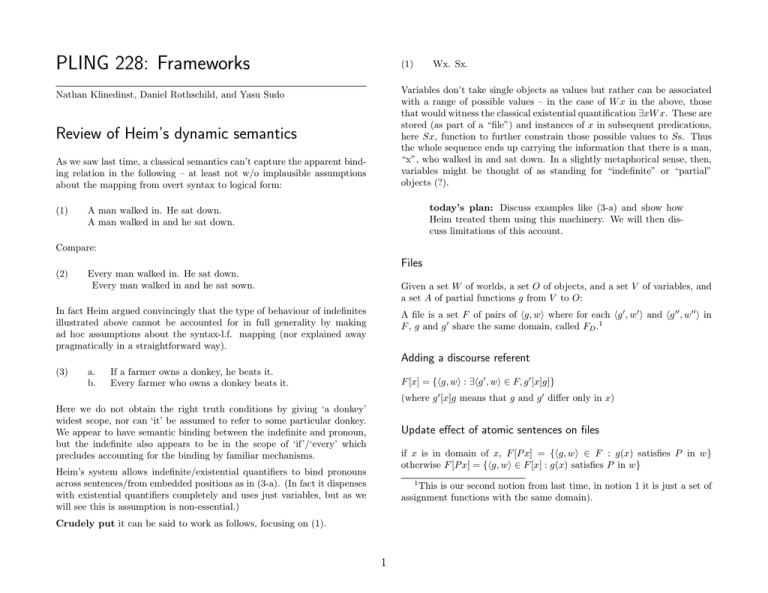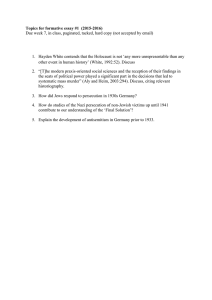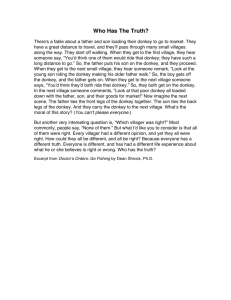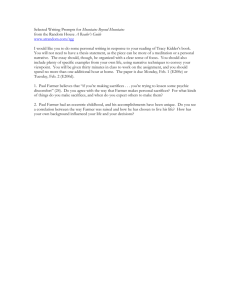PLING 228: Frameworks
advertisement

PLING 228: Frameworks
(1)
Variables don’t take single objects as values but rather can be associated
with a range of possible values – in the case of W x in the above, those
that would witness the classical existential quantification ∃xW x. These are
stored (as part of a “file”) and instances of x in subsequent predications,
here Sx, function to further constrain those possible values to Ss. Thus
the whole sequence ends up carrying the information that there is a man,
“x”, who walked in and sat down. In a slightly metaphorical sense, then,
variables might be thought of as standing for “indefinite” or “partial”
objects (?).
Nathan Klinedinst, Daniel Rothschild, and Yasu Sudo
Review of Heim’s dynamic semantics
As we saw last time, a classical semantics can’t capture the apparent binding relation in the following – at least not w/o implausible assumptions
about the mapping from overt syntax to logical form:
(1)
Wx. Sx.
today’s plan: Discuss examples like (3-a) and show how
Heim treated them using this machinery. We will then discuss limitations of this account.
A man walked in. He sat down.
A man walked in and he sat down.
Compare:
Files
(2)
Every man walked in. He sat down.
Every man walked in and he sat sown.
Given a set W of worlds, a set O of objects, and a set V of variables, and
a set A of partial functions g from V to O:
In fact Heim argued convincingly that the type of behaviour of indefinites
illustrated above cannot be accounted for in full generality by making
ad hoc assumptions about the syntax-l.f. mapping (nor explained away
pragmatically in a straightforward way).
A file is a set F of pairs of hg, wi where for each hg 0 , w0 i and hg 00 , w00 i in
F , g and g 0 share the same domain, called FD .1
Adding a discourse referent
(3)
a.
b.
If a farmer owns a donkey, he beats it.
Every farmer who owns a donkey beats it.
F [x] = {hg, wi : ∃hg 0 , wi ∈ F, g 0 [x]g]}
(where g 0 [x]g means that g and g 0 differ only in x)
Here we do not obtain the right truth conditions by giving ‘a donkey’
widest scope, nor can ‘it’ be assumed to refer to some particular donkey.
We appear to have semantic binding between the indefinite and pronoun,
but the indefinite also appears to be in the scope of ‘if’/‘every’ which
precludes accounting for the binding by familiar mechanisms.
Update effect of atomic sentences on files
if x is in domain of x, F [P x] = {hg, wi ∈ F : g(x) satisfies P in w}
otherwise F [P x] = {hg, wi ∈ F [x] : g(x) satisfies P in w}
Heim’s system allows indefinite/existential quantifiers to bind pronouns
across sentences/from embedded positions as in (3-a). (In fact it dispenses
with existential quantifiers completely and uses just variables, but as we
will see this is assumption is non-essential.)
1
This is our second notion from last time, in notion 1 it is just a set of
assignment functions with the same domain).
Crudely put it can be said to work as follows, focusing on (1).
1
Update effects of complex sentences
Let’s compute the update effect. First we know that:
F [(F x&Dy&Oxy) → Bxy] =
F F [F x&Dy&Oxy][¬Bxy] =
F F [F x][Dy][Oxy][¬Bxy]
F [φ & ψ] = F [φ][ψ]
F [¬φ] = F F [φ]
F F 0 = {hg, wi ∈ F : there is no hg 0 , wi ∈ F 0 such that g 0 ≥ g}
(where g 0 ≥ g if g 0 agrees with g in the domain of g).
Let’s suppose:
F [φ → ψ] = F F [φ][¬ψ]
i. F = {h∅, w1i, h∅, w2i}
two farmers, a and b, and at most two donkeys d1, d2:
note on negation
ii. in w1 farmer a owns both of the donkeys d1 and d2
iii. in w2 farmer b owns donkey d1 , d2 is dead.
Quick illustration of the rule for negation. Suppose F = {h∅, ui, h∅, vi},
and let D = {a, b}. Suppose a is P in w and nothing is in v . Then
iv. in w3 both donkeys dead.
F [¬P x]
Then we have
F [F x] =
= F Px
= {h∅, ui, h∅, vi} {hx → a, ui}
= {h∅, vi}
So, the update effect of ¬φ is to make a file incompatible with (further)
update with φ.
The above example should illustrate why is needed to give a general
compositional rule for ¬φ: new variables can be added, as in the case of
P x above, in which case F and F [φ] are disjoint. Notice that if x is already
in the domain of F , the update effect of ¬P x behaves in the more familiar,
purely eliminative way: F [¬P x] = F − F [P x].
, w1 ,
, w1 ,
, w2 ,
, w2 ,
, w3 ,
, w3
⇒ info hypothetically added that there’s a farmer, x,
x→a
x→a
,
w1
,
,
w1
,
y → d1
y → d2
x→b
x→b
F [F x][Dy] =
, w1 ,
, w1 ,
y → d1
y → d2
x→a
x→b
, w2 ,
, w2
y → d1
y → d1
Donkey anaphora
The phenomenon exhibited by the famous examples (3-a) discussed above
is called donkey anaphora.
⇒ and further that there’s a donkey, y,
x→a
x→a
x→b
F [F x][Dy][Oxy] =
, w1 ,
, w1 ,
, w2
y → d1
y → d2
y → d1
The definition of the conditional we gave above is not Heim’s but is useful
to illustrate the general way in which her system handles donkey anaphora.
(4)
that
x→a
x→b
x→a
x→b
x→a
x→b
If a farmer owns a donkey, he beats it.
(F x & Dy & Oxy) → Bxy
⇒ and further that x owns y,
Let’s now suppose that:
2
iv. in w1 farmer a beats d1 but not d2 .
Or bringing it closer to our system above:
v. in w2 farmer b beats d1 .
(6)
Every [Fy & Dx & Oxy] [Bxy]
Then,
Heim’s proposal for interpreting such structures is the following:
F [F x][Dy][Oxy][¬Bxy]
= F [F x][Dy][Oxy] F [F x][Dy][Oxy][Bxy]
x→a
x→b
= F [F x][Dy][Oxy]
, w1 ,
, w2
y → d1
y → d1
x→a
=
, w1
y → d2
Heim’s update rule for ‘every’
F Every φ ψ = {hg, wi ∈ F : for every hg 0 , wi ∈ F [φ] such that g 0 ≥
g, there is a hg 00 , wi ∈ F [φ][ψ] such that g 00 ≥ g 0 }
Heim further assumed, about the syntax-semantics mapping, that the variable associated with a noun in a quantified noun phrase like ‘every farmer’
(y above) must not already be in the variable domain.
⇒ and finally that x doesn’t beat y.
Now the final result:
F F [F x][Dy][Oxy][¬Bxy] = {h∅, w2i, h∅, w3i}
example.
To summarise: the update effect of (F x&Dy&Oxy) → Bxy on our
file F was to eliminate w1 [that is, h∅, w1i]. Put another way it added the
(worldly) info that every farmer beats all his donkeys. w1 was “subtracted”
because it would survive updating F with the info that there’s a farmer
who doesn’t own his donkey.
Let’s return to our toy F above and compute the update effect of (6)
according to this rule.
Note that if in (iv.) it had been assumed that a beats both d1 and d2,
F [F x][Dy][Oxy][¬Bxy] would have been ∅ and thus w1 would also have
been retained in the final update.
From above F [F x][Dy][Oxy] =
x→a
x→a
x→b
, w1 ,
, w1 ,
, w2
.
y → d1
y → d2
y → d1
Tripartite quantification
and F [F x][Dy][Oxy][Bxy] =
According to the rule we retain from F just those assignment-worlds in
F all of whom’s extensions in F [F x][Dy][Oxy] – the “restrictor” – have
extensions themselves in F [F x][Dy][Oxy][Bxy] – the nuclear scope.
How about (3-b), ‘Every farmer who owns a donkey beats it’ ? We could
represent this in various ways in the Heimian system above.
F [F x][Dy][Oxy][Bxy] =
x→a
y → d1
x→b
, w1 ,
, w2
y → d1
In fact however, Heim defined her semantics for natural language (English)
rather than a simple logical language like the above. Thus for reasons
of syntactic plausibility and semantic necessity she assumed “tripartite”
structures for quantificational sentences (including conditionals, as we will
see below). That is something like:
This means
that we keepw3 (trivially) and w2 but not w1. The reason
x→a
, w1 extends h∅, w1i from F , but does not have an
is that
y → d2
extension in F [F x][Dy][Oxy][Bxy].
(5)
In summary: The update effect of (3-b) is the same as that of (3-a). Farmers must beat all their donkeys. An interesting feature of this treatment is
that ‘every’ does not function in the familiar way as a binder of a variable
Every [farmer who owns a donkey] [beats it]
3
associated with ‘farmer’. Rather it quantifies over extensions of of worldassignments, which amounts in this case to quantifying “unselectively”,
over farmer-donkey pairs.
(10)
As we will see this leads to problems. But first
Following ideas of Lewis (and Kratzer), Heim assumed a tripartite structure for sentences like (10),
good (?) results
(11)
(7)
If a bishop meets a bishop, he blesses him. [Heim, 1990]
(8)
If a woman buys a sage plant, she buys eight others along with it.
[Heim, 1990]
Always [if a woman comes to John’s office] [John hits on her]
and she proposed a semantics for such structures essentially identical to her
treatment of (3-b). The adverb quantifies over (extensions of) assignmentworlds in a file. The result is that in a sentence with multiple indefinites,
parallel to (3-b), the quantification is again effectively over farmer-donkey
pairs:
These examples were take to suggest that a purely formal means of tracking
anaphoric relations is necessary. Heim’s system provides this since the
pronouns are linked to their indefinite binders by simple variable identity:
e.g. the first bishop and first (?) pronoun are represented with x, the
second pair with y. Heim argues that there does not appear to be plausible,
sufficient information to resolve the anaphoric relationship by interpreting
the pronoun as (literally) a (stand in) for a description as in Evans [1977],
Cooper [1979]). But it is not clear in hindsight that such examples provide
a strong argument for dynamic view.
(12)
Always/usually, if a farmer owns a donkey, he beats it.
The proportion problem
As Heim [1990] noted this feature of her account gives rise to what is
known as the Proportion Problem. Consider:
A second result is that the treatment of universal (as opposed to existential) quantification does not result in new variables being added to the
domain. I.e. no new discourse referents are introduced and so there should
not be further possibilities for anaphora (2).
(13)
a.
b.
Most farmers who own a donkey beat it.
Usually if a farmer owns a donkey he beats it.
As noted these on Heim’s system will effectively involve proportional quantification over farmer-donkey pairs: most such pairs such that the farmer
owns the donkey must be such that he beats it. But this is clearly not
right. To take her example suppose 1 farmer is rich but cruel and beats
all 200 donkeys he owns. The other 99 farmers do not beat their single
donkey. Clearly (13-a) is false. It involve counting of farmers not farmer
donkey pairs. Same for (b).
Back to conditionals
Heim’s treatment of donkey anaphora owes much to Lewis [1975], who
made two important observations. First, that ‘if’ clauses seem to behave
like restrictors of the domain of quantification of adverbial or modal expressions
(9)
Always/usually, if a woman come to his office, John hits on her.
“John hits on most/all women that come to his office”
Notice that the problem here arises from an otherwise plausible lexical
entry (given Heim’s system) for ‘most’/‘usually’, along the lines of:
Usually, if John comes, Mary is upset.
“On most occasions on which John comes, Mary is upset”
Heimian update rule for ‘most’
Second, that when they do, the adverbial behaves as if it “unselectively”
binds indefinites in its scope
F Most/Usually φ ψ = {hg, wi ∈ F : for most hg 0 , wi ∈ F [φ] such that g 0 ≥
g, there is a hg 00 , wi ∈ F [φ][ψ] such that g 00 ≥ g 0 }
4
References
The issue here is not just with ‘most’, as Chierchia points out:
(14)
Robin Cooper. The interpretation of pronouns. In F. Heny and H. Schnelle,
editors, Syntax and Semantics 10: Selections from the Third Gröningen
Round Table, pages 61–122. Academic Press, 1979.
At least two farmers who own a donkey beat it.
This should be false in our scenario of the rich but cruel farmer, but comes
out true on Heim’s semantics.
Gareth Evans. Pronouns, quantifiers and relative clauses. Canadian Journal of Philosophy, 7:467–536, 1977.
Universal vs. existential readings
Irene Heim. E-type pronouns and donkey anaphora. Linguistics and Philosophy, 13:137–177, 1990.
As we saw, Heim’s treatment of (3-a) is effectively universal quantification
over farmer-donkey paris. But that seems too strong in other cases:
David Lewis. Adverbs of quantification. In Edward L. Keenan, editor,
Formal Semantics of Natural Language. Cambridge University Press,
1975.
(15)
a.
b.
Every person who had a credit card used it to pay the bill.
(Cooper)
Everyone person who has a dime will put it in the meter.
(Pelletier and Schubert)
What we get in this case is called an Existential Reading – as opposed to
the apparently Universal one found in (3-b), and which Heim predicts.
Similar variation appears to be attested with other quantifiers, though it
has been claimed that there are preferences for Universal vs. Existential
depending on the quantifier.
(16)
a.
b.
No father who has a teenage son lends him the car on weekdays. (Rooth 1987)
existential
No one who has an umbrella leaves it at home on a day like
this. (Chierchia)
universal
next time
More on these problems and possible fixes.
5







